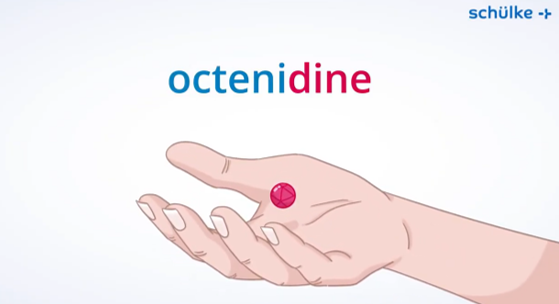Octenidine
The active ingredient octenidine
Octenidine dihydrochloride as a cation-active ingredient is characterized by a pronounced efficacy which is retained even after the actual application and thus continues to keep superficial bacterial colonization low or reduces it further. This effect, known as residual efficacy, can be expected with all skin, mucous membrane and wound antiseptics containing octenidine. Particularly in wound care, the longest possible residual effect is of great advantage. Not only the germs which are already present in the wound are killed, but also newly (externally) invading microorganisms, including those of the skin flora. Octenidine is not absorbed, but remains on the cells of the body surface 1,2 and can demonstrably develop its broad antimicrobial efficacy there for at least 48 hours.3 In practice, it should be noted that products containing octenidine are not rinsed off after use, as otherwise the remanence effect is lost.
1 Jenull et al., Journal of Wound Care 2015 | 2 Müller G et al, GMS Krankenhaushygiene Interdisziplinär 2007 | 3 Lutz JT et al., Infection 2016
The advantages of octenidine

1 Conceição et al., Journal of Global Antimicrobial Resistance 2019 | 2 Alvarez-Marin et al., Antimicrobial Resistance and Infection Control, 2017 | 3 Conceição et al., J Antimicro Chemother 2016 | 4 Koburger et al., J. Antimicrob. Chemother. 2010 | 5 Wisgrill et al., Neonatology2017 | 6 Novakov Mikić & Stojic, Arch Gynecol Obstet 2015 | 7 Briese et al., Arch Gynecol Obstet 2010 | 8 Radischat N et al. Int Wound J. 2020 | 9 Lutz et al., A Journal of Infectious Diseases 2016 | 10 Müller & Kramer, J. Antimicrob. Chemother. 2008 | 11 Bührer et al. Journal of Hospital Infection 2002 | 12 European Medicines Agency 2010 | 13 Severing et al. Biomedicines 2022 | 14 Hübner et al., 2010 | 15 Assadian, 2016
*consider corresponding SmPC/product information
effective spectrum octenidine

1 Yamamoto et al., Biocontrol Sci, 2016 | 2 Baroszewicz et al., Ortopedia, Traumatologia, Rehabilitacja, 2007 | 3 Koburger et al., J Antimicrob Chemother, 2010 | 4 Bock et al., Lett Appl Microbiol, 2018 | 5 Goroncy-Bermes et al., Wound Med, 2013 | 6 Al-Doori et al., J Antimicrob Chemother, 2007 | 7 Alvarez-Marin et al., Eur J Clin Microbiol Infect 2017 | 8 Tirali et al., Oral Surg Oral Med 2009
9 Pitten et al., J Hosp Infect 2003 | 10 Amalaradjou et al., Appl Environ Microbiol 2009 | 11 Anderson et al., J Appl Microbiol 2013 | 12 Kodedova et al., Biotechniques 2011 | 13 Sedlock et al., Antimicrob Agents Chemother 1985 | 14 CKL et al., Bioorg Med Chem 2007
15 Ghannoum et al., Arch Oral Biol 1990 | 16 Ghannoum et al., J Antimicrob Chemother 1990 | 17 Zhou et al. Zhonghua Shao Shang Za Zhi 2001 | 18 Steinhauer et al., J of Hospital Infection 2021 | 19 Ponnachan et al., J Hosp Infection 2019 | 20 Neumann et al. Hamburg 1996 | 21 Silva-Neves et al., Sci Rep 2021 | 22 Friese et al. Arch Gynecol Obstet 2003
Come into the world of octenidine - with our animated videos in the schülke Channel on YouTube.
mode of action octenidine
Have a look at the mode of action of our unique active agent octenidine.
Application of octenisept® Wound and Mucous Membrane Antiseptic
Application of octenilin® Wound Gel & octenilin® Wound Irrigation
Have a look at the application of octenilin® Wound Gel & octenilin® Wound Irrigation Solution developed by schülke.


























